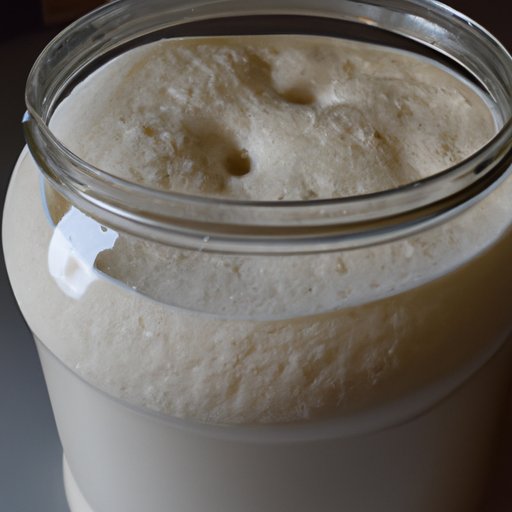Introduction
Sourdough starter is a fundamental ingredient in the baking process. It is a mixture of flour, water, and wild yeast that helps give bread its unique flavor and texture. But before you can bake with it, you need to know if your sourdough starter is ready. In this article, we’ll explain how to tell when your starter is ready by analyzing its appearance, performing a float test, watching for bubbles and foam, examining the smell, testing with pH strips, and monitoring the temperature.

Analyzing the Appearance of the Starter
When you first mix up your starter, it will look like a thick paste. Over time, it should start to become more liquid-like. When it reaches this point, you’ll want to take a closer look at the starter to see if it’s ready. You should be looking for signs of fermentation such as bubbles or foam on the surface of the starter. If you see these signs, then your starter is ready.
You’ll also want to pay attention to the color of the starter. A healthy starter should be light in color, while an unhealthy one will be darker. This is a good indicator of how active the starter is.
Performing a Float Test
Another way to tell if your starter is ready is by performing a float test. To do this, take a spoonful of starter and drop it into a cup of room-temperature water. If the starter floats, it means that it is full of carbon dioxide and is ready to use. If it sinks, however, it means that it needs more time to ferment and develop.

Watching for Bubbles and Foam
Bubbles and foam are another indication that your starter is ready. As the starter ferments, it will produce carbon dioxide which will cause tiny bubbles to form in the starter. These bubbles should be small and uniform in size. Foam, on the other hand, is usually larger and coarser. Both of these indicate that the starter is ready to use.
Examining the Smell of the Starter
The smell of your starter can also tell you if it’s ready. A healthy starter should have a pleasant, slightly sour smell. If it smells off or overly sour, then it may not be ready yet. You should also pay attention to the consistency of the starter. It should be thick but still pourable.
Testing with pH Strips
Testing the starter with pH strips is another way to tell if it’s ready. The ideal pH range for a healthy starter is 4.0-4.5. If the pH is higher than this, it could mean that the starter has been overfed and is not ready to use. If the pH is lower than this, it could mean that the starter is too acidic and needs more time to ferment.

Monitoring the Temperature of the Starter
Finally, you’ll want to keep an eye on the temperature of your starter. The ideal temperature range for a healthy starter is between 70-80°F. If the temperature is outside of this range, it could mean that the starter is not ready to use. If the temperature is too high, it could mean that the starter is overactive and needs to be fed more often. If the temperature is too low, it could mean that the starter is not fermenting properly and needs more time to develop.
Conclusion
Knowing whether or not your sourdough starter is ready can be tricky. But by taking the time to analyze its appearance, performing a float test, watching for bubbles and foam, examining the smell, testing with pH strips, and monitoring the temperature, you can get a better idea of when your starter is ready to use.
(Note: Is this article not meeting your expectations? Do you have knowledge or insights to share? Unlock new opportunities and expand your reach by joining our authors team. Click Registration to join us and share your expertise with our readers.)
